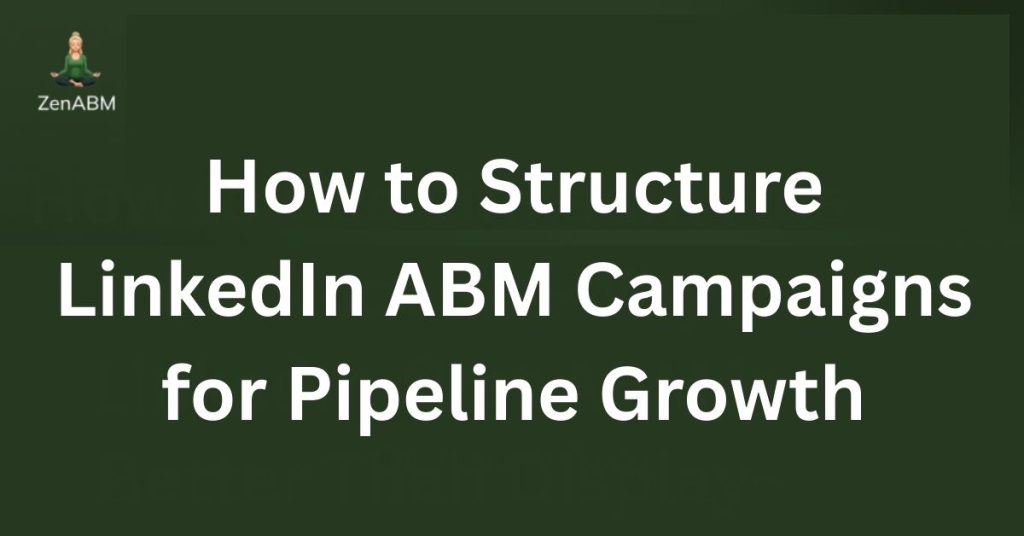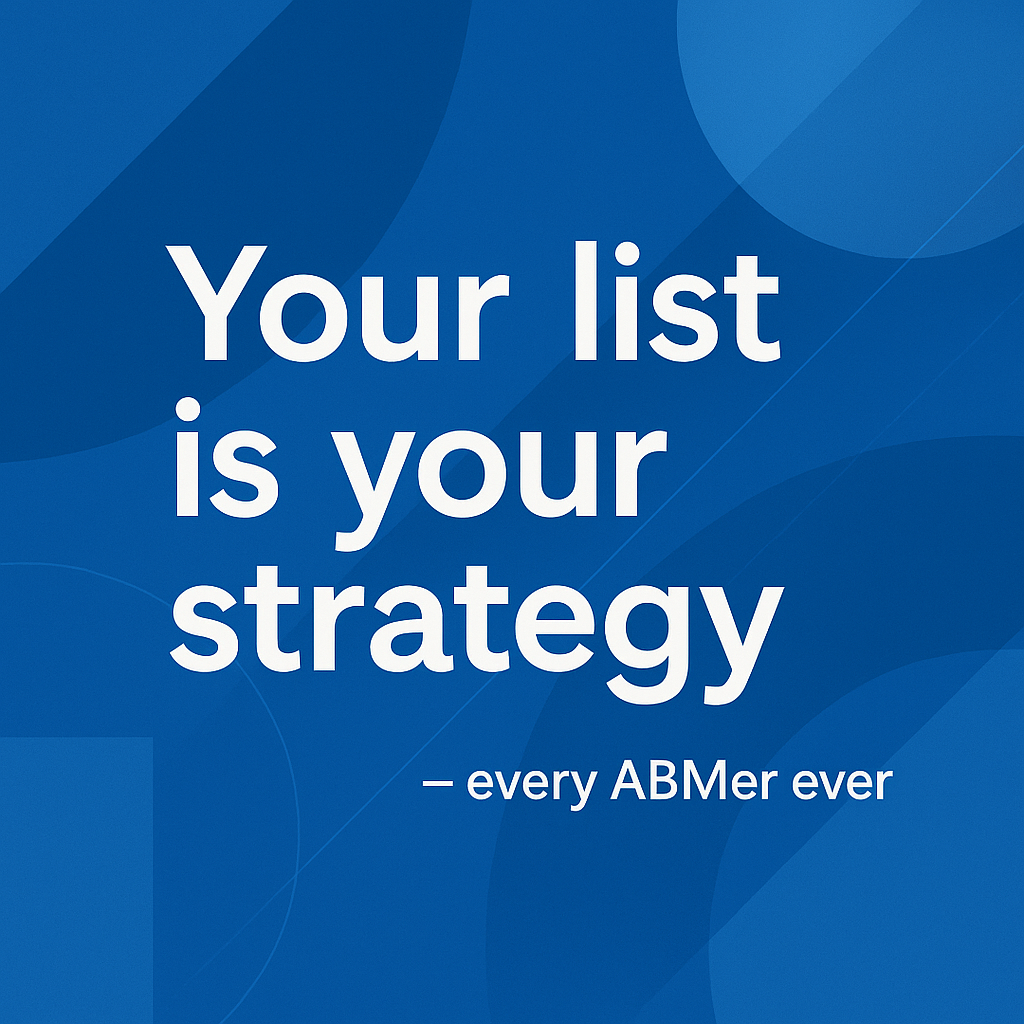Think of this as a working kit rather than a blog post. You will find a complete blueprint for structuring LinkedIn ABM campaigns that actually move the pipeline, plus a stack of free templates you can copy. I will also show where ZenABM fits, so your build does not stall in spreadsheets.
Grab what you need and start shipping.
LinkedIn ABM campaign structure for pipeline growth: quick summary
End to end flow: Set revenue aligned goals and KPIs → pick and tier your target accounts (1:1, 1:few, 1:many) → tighten ICP from CRM, LinkedIn, and enrichment → map buying groups plus SPICED style pains and triggers → write persona level value props → architect your LinkedIn ABM campaign hierarchy by intent, stage, and format → plan content for each stage of the journey (identified, aware, interested, consideration, selecting) → launch coordinated ads, email, and sales touchpoints → manage assets with a clear hierarchy (ABM campaign, group, campaign, ad) → enable sales with content, talk tracks, and engagement alerts → track account movement and campaign health in real time → let ZenABM automate attribution, CRM syncs, and reporting → optimize for ROAS, stage conversion, and pipeline velocity.
Free templates:
- ICP Template
- ABM Budget Calculator
- Account Map or Dossier Templates: Download Template 1, Download Template 2
- Wouter Dieleman’s SPICED-driven ABM Account Mapping Template
- Intent-based LinkedIn ABM Campaign Structure Template
- ABM Stages Framework Example
- Campaign and Ad Asset Management Template: Excel Version, Notion Version
Tool stack for your LinkedIn ABM plan:
- CRM: Salesforce, HubSpot
- Marketing Automation: Marketo, Pardot, HubSpot
- Advertising: LinkedIn Ads, Demandbase, RollWorks
- ABM and Analytics: ZenABM for LinkedIn engagement by company, automatic CRM sync, intent tagging, built-in ROI and attribution dashboards
- Data Enrichment: ZoomInfo, Clearbit, LinkedIn Sales Navigator, Clay
- Sales Engagement: Salesloft, Outreach.io
- Collaboration and Assets: Notion, Excel, Asana
- Direct Mail and Gifting: Sendoso, Alyce
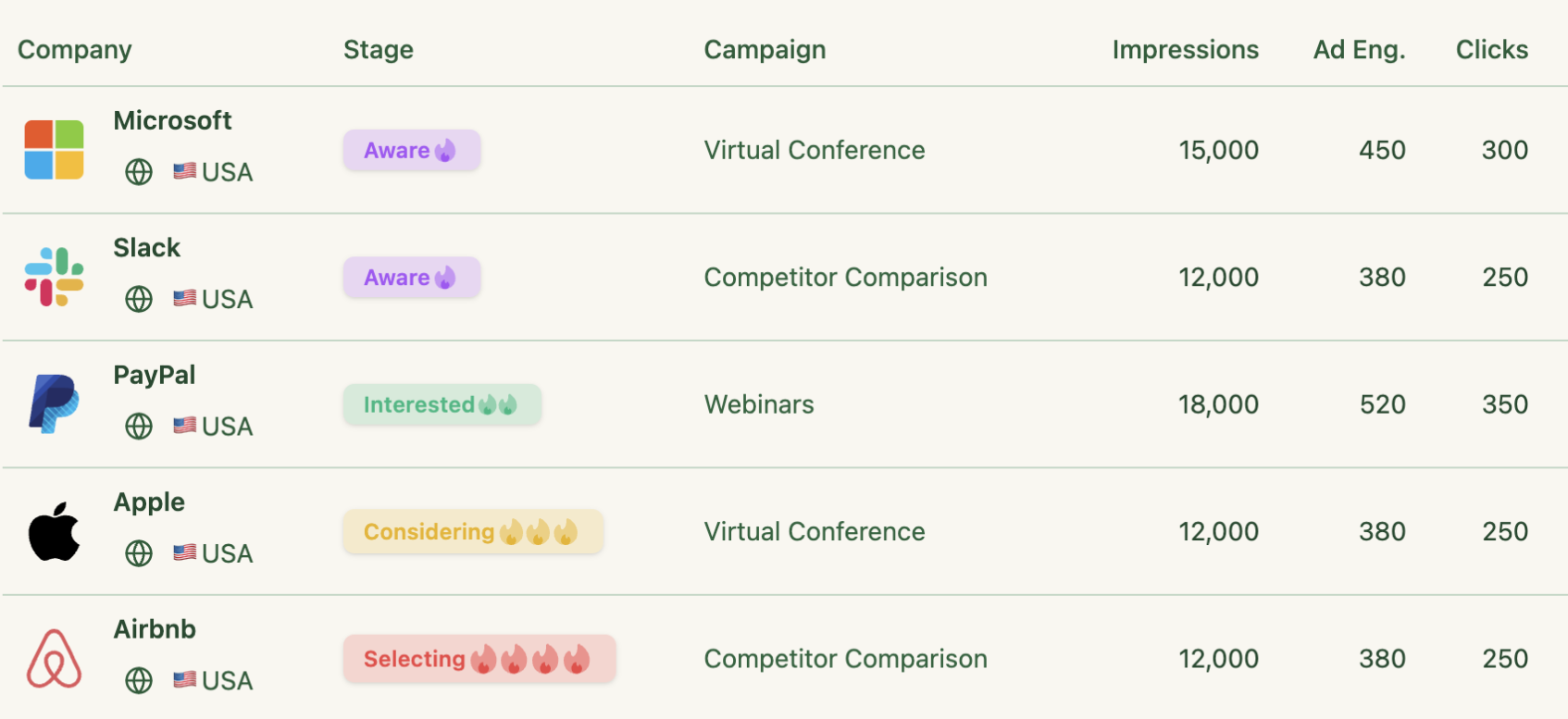
What is a LinkedIn ABM campaign structure, and why does it matter
An ABM structure is a living plan that organizes how your team targets accounts, deploys creative, and measures progress across LinkedIn and partner channels. It keeps complex work tidy, aligns marketing, sales, and RevOps around the same accounts and KPIs, and prevents naming chaos that wrecks reporting.
Build it to plug into your CRM and ABM platform. If you use ZenABM, the handoff to analytics and attribution stays clean and painless.
What a good LinkedIn ABM structure includes
Most teams track these elements in a spreadsheet or Notion doc:
- Target Account List and tiers with the reasons each account is in Tier 1, 2, or 3.
- Personas you must reach and what they care about.
- Campaign hierarchy by intent, journey stage, and channel.
- Content and offers mapped to personas and stages.
- Channels and tactics such as LinkedIn, email, events, and outbound.
- Timeline and ownership so launches do not drift.
- Metrics and KPIs for pipeline, conversion, and engagement.
Approaches and tiering for LinkedIn ABM
Decide the flavor of ABM you will run, then segment your TAL accordingly.
| Tier | Accounts | Strategy and personalization | Tactics |
|---|---|---|---|
| Tier 1: Strategic ABM (1:1) | Top 10 to 20 whales | Deep personalization with custom plans | Custom content, executive and BDR outreach |
| Tier 2: Scale ABM (1:few) | Next 50 to 100 high-value accounts | Semi-personalized, segmented by industry or use case | Segment-specific content and narrative |
| Tier 3: Programmatic ABM (1:many) | Broader ICP list of 100 to 200 plus | Lighter personalization with automation | LinkedIn ads, webinars, nurtures |
Why tiering helps
It protects the budget and attention. You will not burn Tier 3 with $500 hyper-custom videos on $250 potential deals.
Pro tip: Start with one-to-many to surface interest, then swing resources to the accounts that show heat. You do not need to worship the classic triangle:
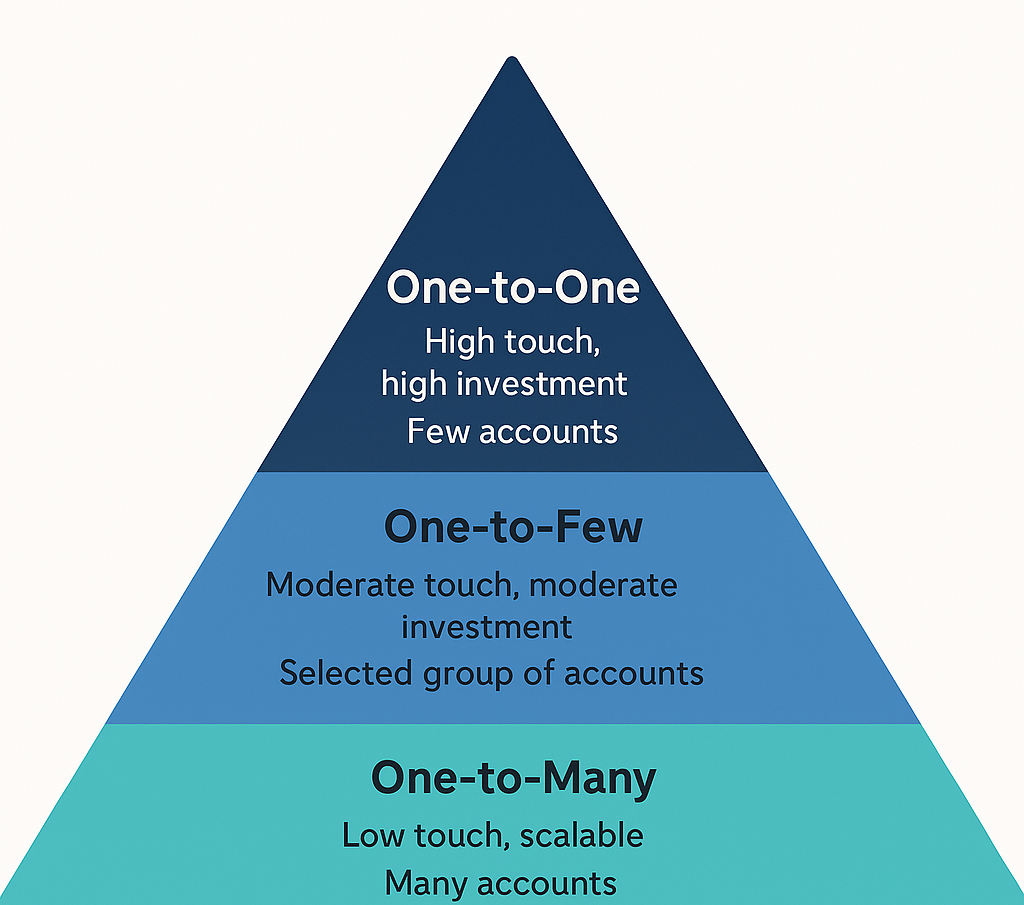
ABM leader Rhiannon Blackwell argued for a more responsive model in this Momentum ITSMA guide, urging teams to adapt tiering based on signals, not dogma.

Bottom line: Tiering is about timing and intent as much as deal size. Accounts can move up when engagement merits it.
Step 1: Lock goals and KPIs that tie to revenue
Pick outcomes that sales cares about, then work backwards. Add an OKR section to your template so targets are visible and owned.
Revenue and pipeline targets plus ad budget
Set a closed won number, then compute the needed pipeline from your historic win rate. If you want one million in new ARR and your close rate is 50 per cent, you need two million in qualified pipeline. Work from revenue to pipeline to ad budget. At Userpilot, the team aimed for three point five million in pipeline with a three hundred and fifty thousand annual ABM budget, which implies ten dollars in pipeline for every dollar spent. Use the free ABM Budget Calculator if you want help with the math.
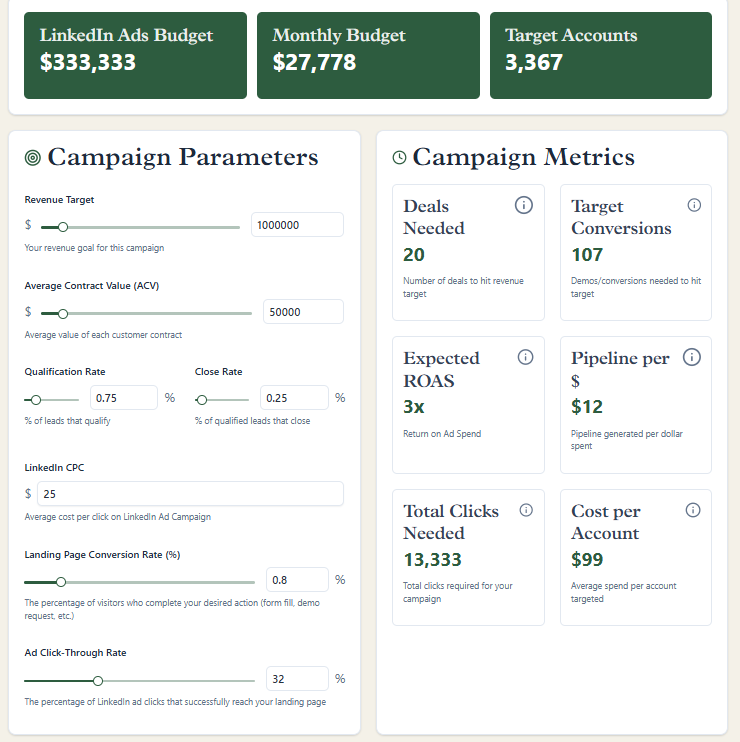
Account engagement targets
Make engagement a first-class metric. For a list of one hundred targets, you might aim for sixty to become aware, thirty to show interest, and ten to reach sales conversation. Track movement between stages so you can see leaks. ZenABM visualizes stage progress clearly:
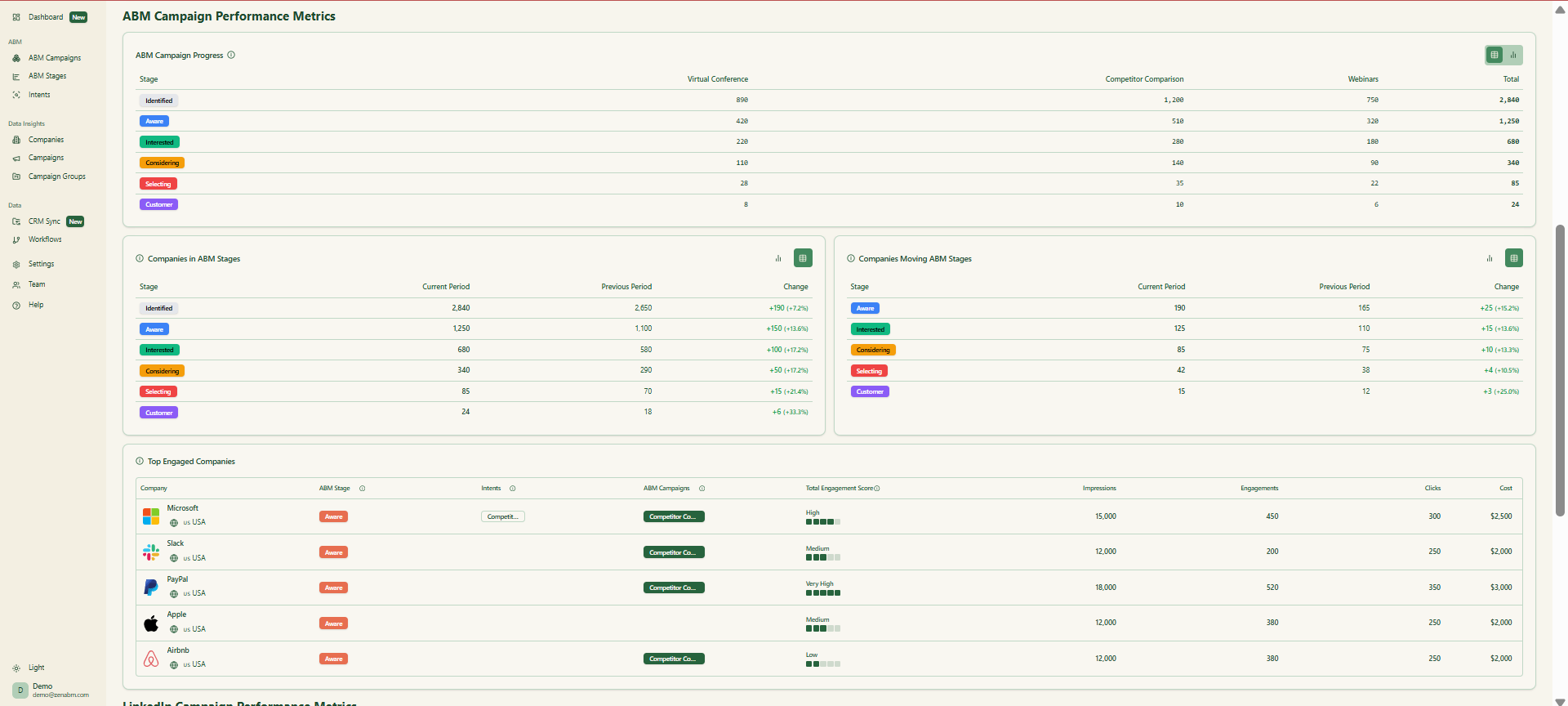
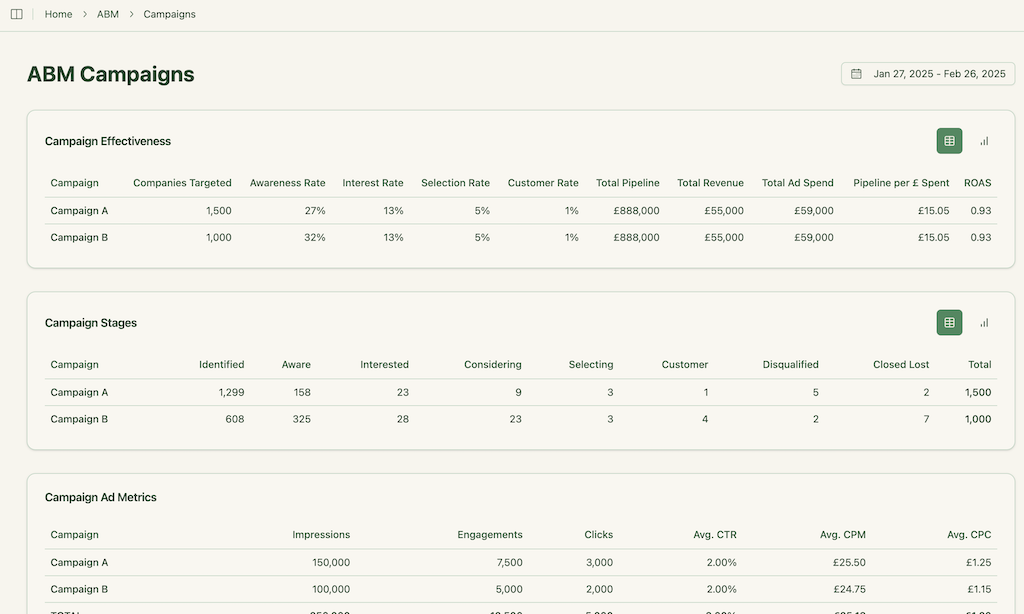
Recommended stages: Identified, Aware, Interested, Consideration, Opportunity, Customer.
Leading indicators
Set early proof points. Examples include per cent of TAL that clicks, the number of high-value content downloads, and meeting requests by persona. A target like twenty-five per cent of accounts engaging in two months keeps the team focused.
Efficiency metrics
Do not stop at totals. Track cost per engaged account, cost per opportunity, pipeline per dollar, ROAS. Measure at every level in the hierarchy so you can prune waste confidently. If you run primarily on LinkedIn, ZenABM matches engaged companies to deals in your CRM and computes these numbers for you.

Step 2: Pick target accounts and tier them with a clear ICP
Work with Sales and Customer Success to define ICP and build the TAL. Ask which wins were fast and healthy, then look for patterns in industry, size, region, use case, and triggers. Joint ownership keeps alignment real, not performative.
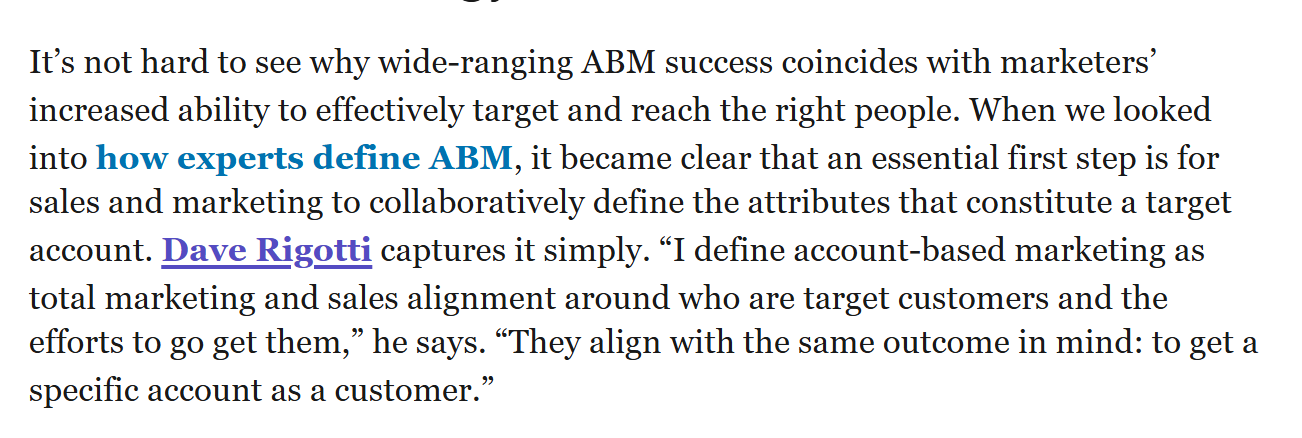
Use this ICP template to lock consensus:
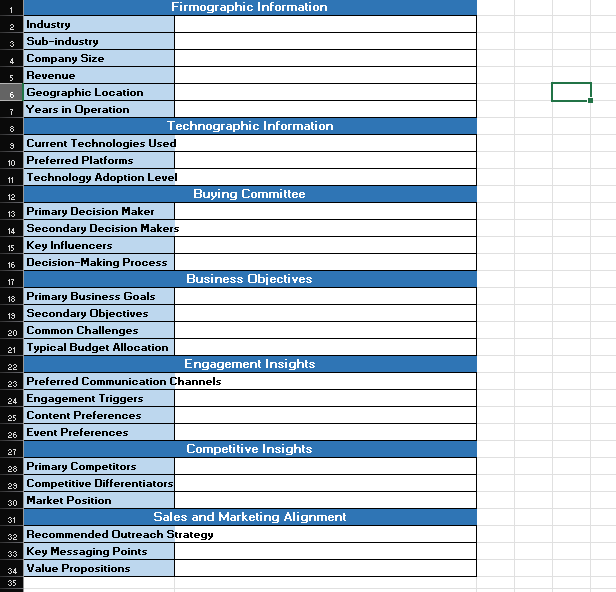
Helpful sources while you compile the list:
- LinkedIn Sales Navigator for firmographic filters. Export a seed list and refine with Clay.
- CRM and marketing data for accounts with recent engagement or strong fit that slipped in the past.
- Third-party enrichment such as ZoomInfo, Clearbit, and Clay. Add technographics and intent where helpful. Userpilot filtered against competitor stacks using BuiltWith plus Clay and saw faster traction.
- Tier assignment when the list is ready. Sort by value and timing, then by intent and signals.
Step 3: Map account data, buying groups, and pain points
For Tier 1 and Tier 2, build a dossier for each account. Record firmographics and technographics, the decision-making unit, and known pains by persona.
Template preview:
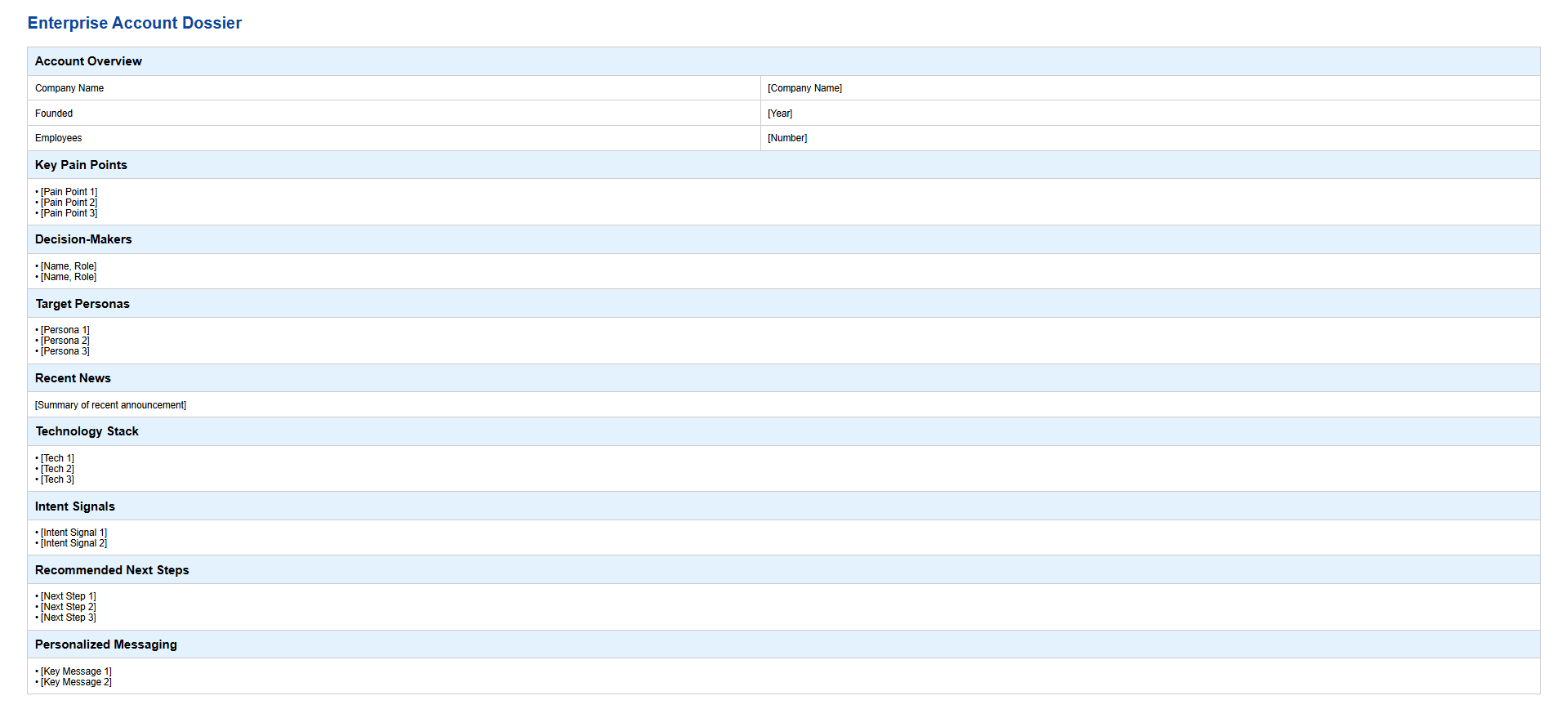
Excel version here:
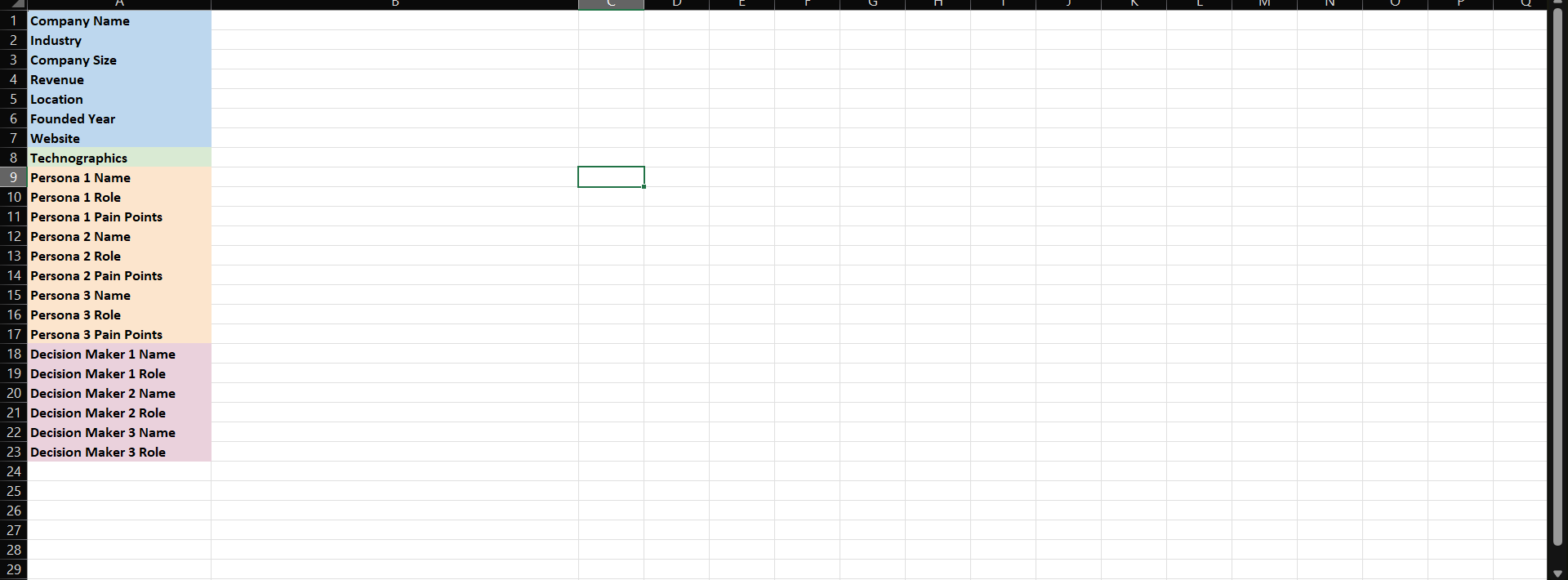
Download it here.
Layer in SPICED as Wouter Dieleman suggests:
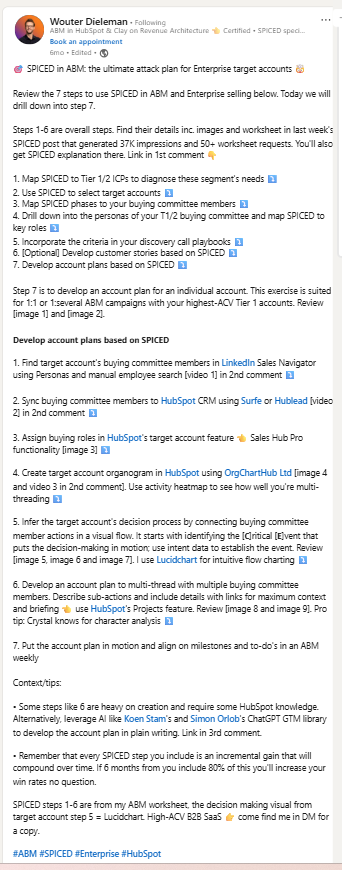
Capture Situation, Pain, Impact, Critical Event, and Decision path per account, and when possible per persona. Your dossier ends up like this:
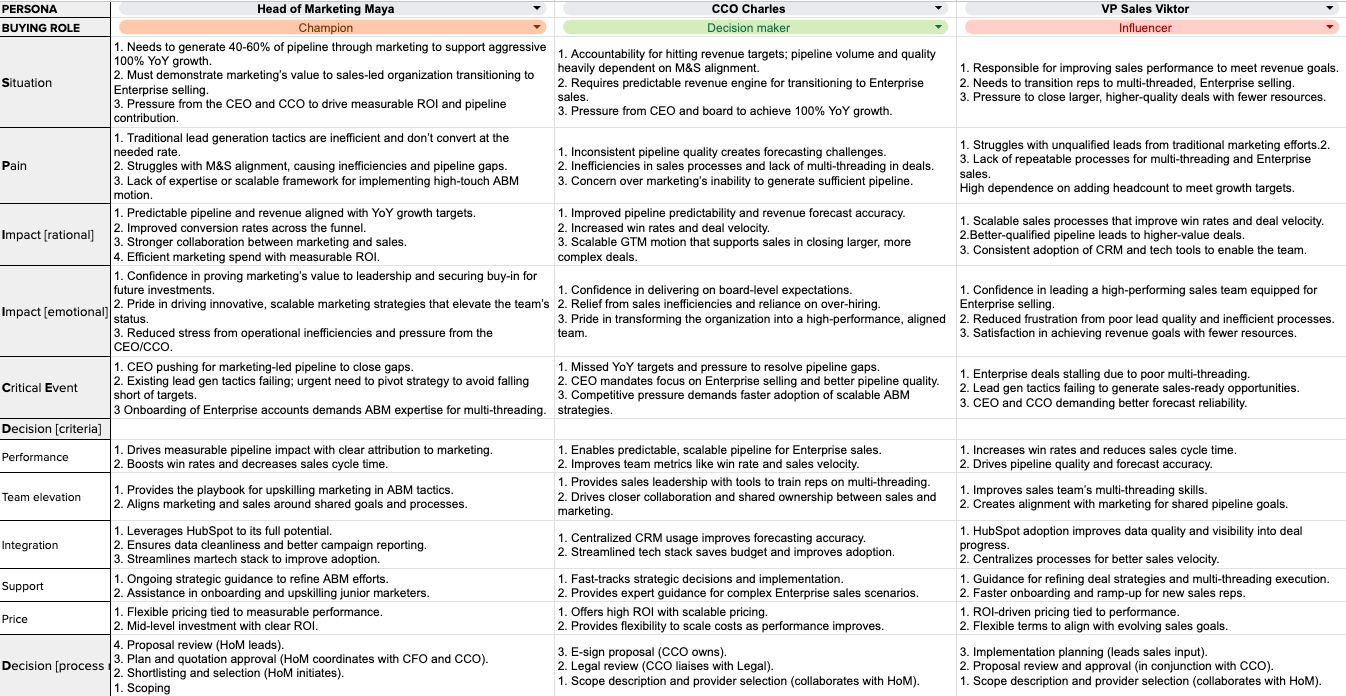
Step 4: Write value propositions and messaging by account or segment
Now translate pains into crisp narratives. If your LinkedIn ABM program targets fintech, your umbrella theme might be customer engagement. The CTO hears cost and reliability. The VP Product hears adoption without more engineering. The CEO hears ARR growth and retention. Capture a simple messaging matrix in your template so content and sales use the same language.
Step 5: Build your LinkedIn ABM campaign structure and content
Choose the channel and tactics
For ads, start on LinkedIn. It is where B2B lives. Target companies, lookalikes, and the exact roles you need. Display is a poor substitute because of fraud and weak identity:
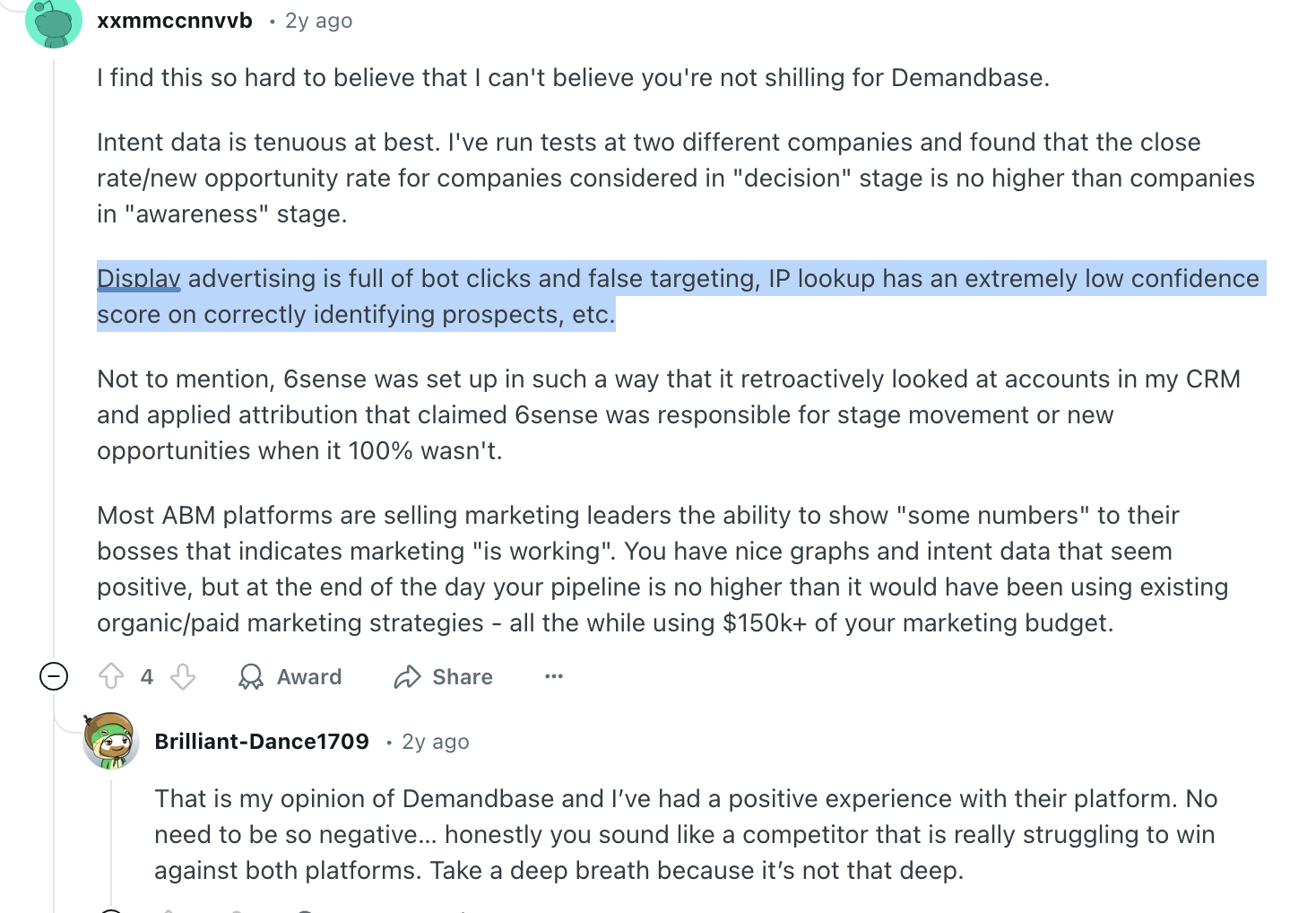
DSPs do not give you a company identity out of the box. IP matching tools try to fill the gap, yet accuracy tops at 42% in tests:

LinkedIn, by contrast, exposes account signals easily inside Campaign Manager:
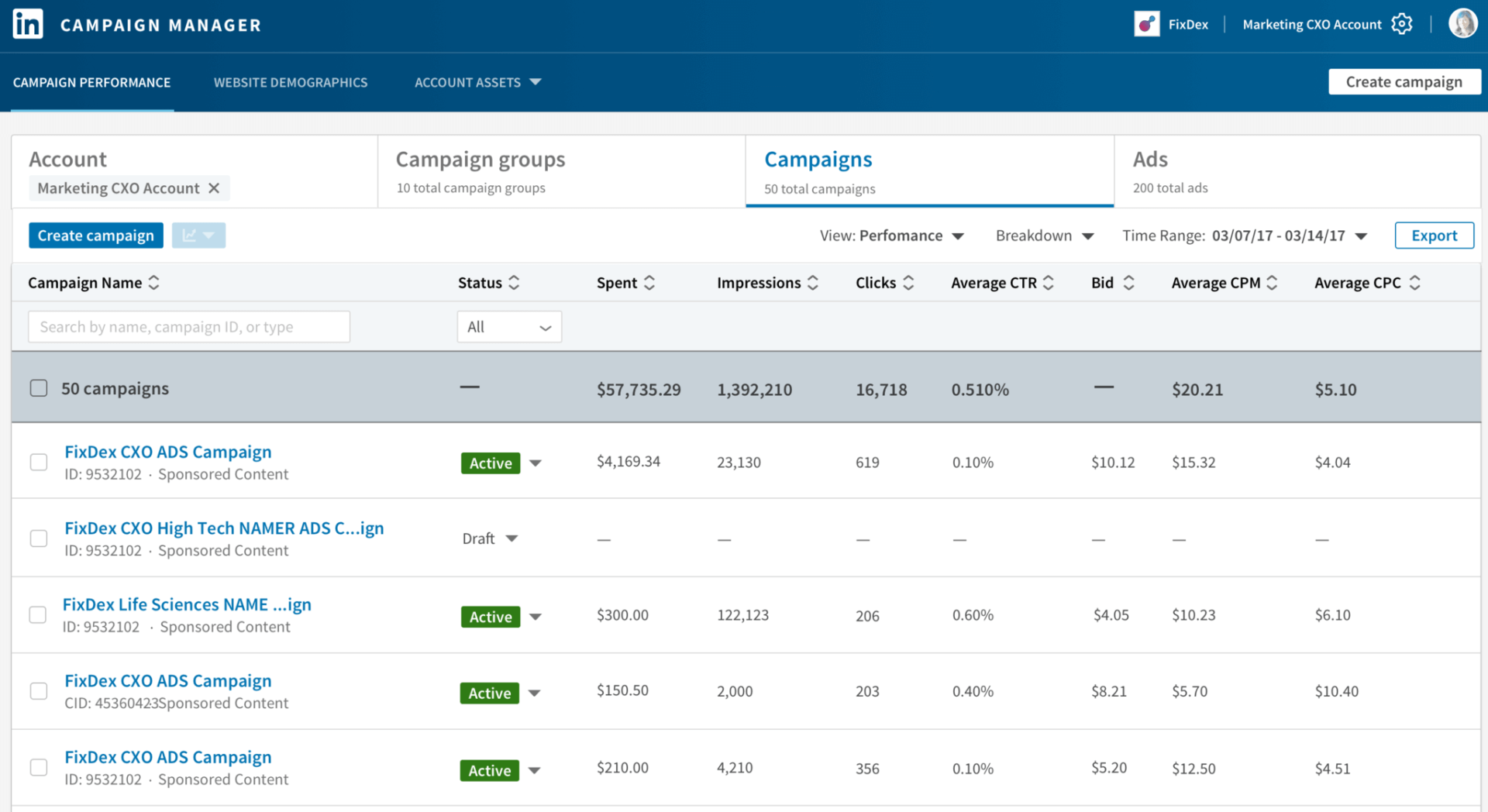
Campaign Manager rolls totals at the ad account level. ZenABM breaks it down per campaign so you can see who engaged with what:
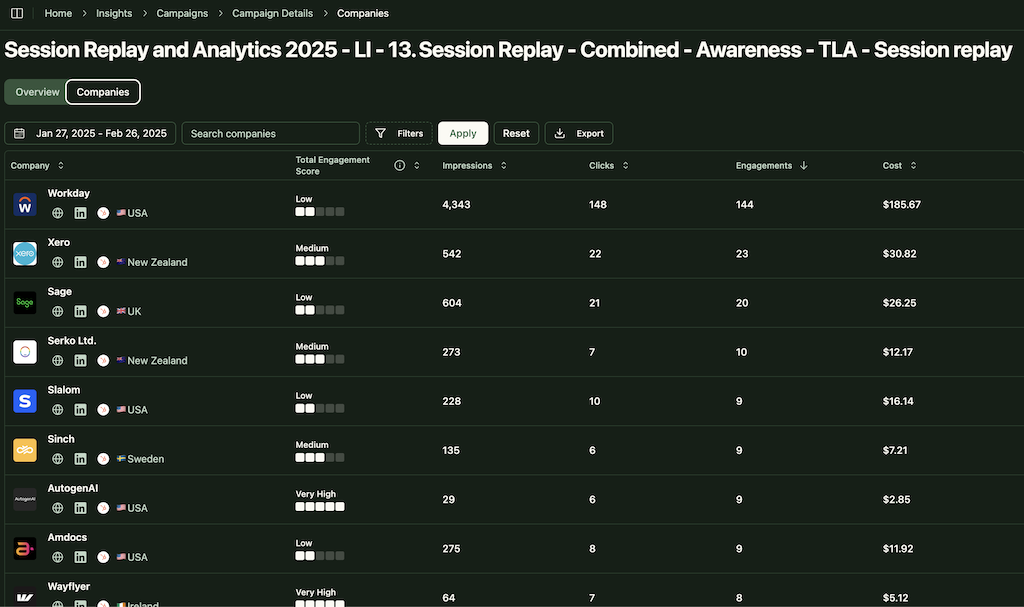
Start on LinkedIn. Add other channels when the machine is humming.
Design the LinkedIn hierarchy
Account targeting
Upload your TAL with Matched Audiences in Campaign Manager. Lists under three hundred companies may not match well, so group a few small segments. Layer job titles or functions so your ads reach the right people inside those accounts.
Campaign structure
Mirror intent in Campaign Groups. If you have two core value props, build two groups and keep the creative theme pure inside each. Within a group, add campaigns by format or stage. For example, Group Improve Onboarding might include an awareness campaign with feed posts, then a consideration campaign that promotes a webinar or case study. Map all of this in your template so building in LinkedIn is a copy task, not a rethink.
Userpilot structured its ABM campaign around intent like this:
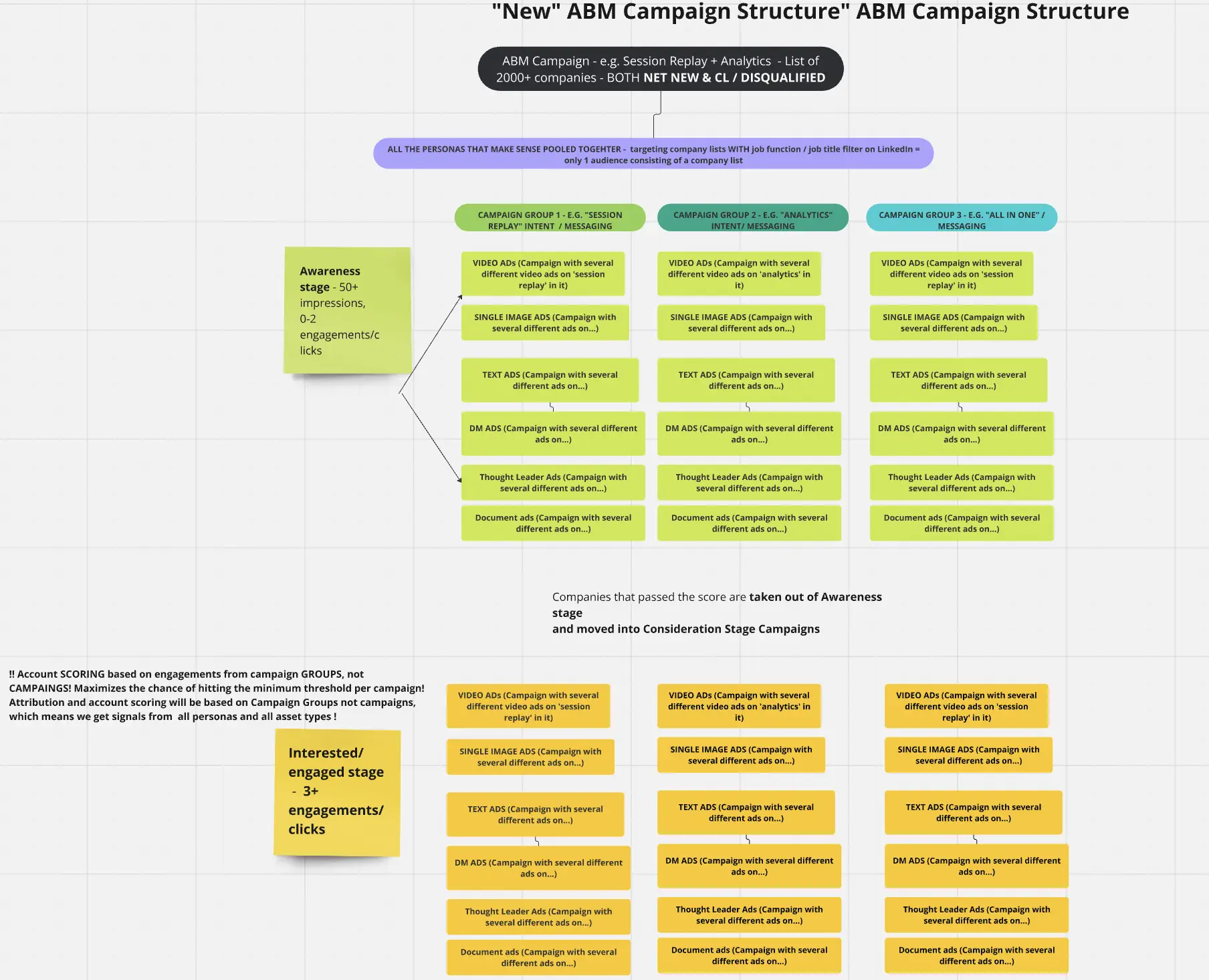
Ad formats
Pick formats with purpose and note them in the template:
- Sponsored Content for broad reach in the feed. Single images and videos often win for CTR.
- Video for demos and storytelling. Great engagement, you pay per view.
- Carousel to show multiple benefits or steps.
- Conversation Ads for Tier 1 and Tier 2. Use sender credibility and short paths. For Tier 1, personalize heavily.
- Text and Dynamic Ads in the sidebar. Low-cost touchpoints that support awareness.
- Organic posts from the company and leaders. Cadence lends credibility. It is hard to attribute but useful air cover.
- Frequency and budget by tier. Tier 1 gets higher spend per account. Tier 3 gets a lighter, steadier presence. Aim for two to three impressions per week early, then ramp up the accounts that engage.
Pro tip: Run a cheap awareness wave first. Then rebuild your TAL around the companies that engaged. Text and Spotlight ads can deliver huge impressions at tiny CPMs. Tim Davidson reported two hundred thirteen thousand plus impressions for two hundred seventy-six dollars, which is near one dollar CPM. Source below.
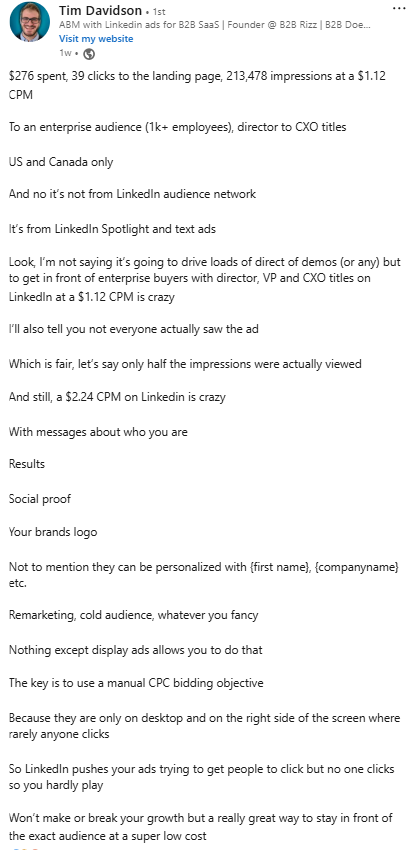
Outside ads, structure supporting channels too:
- Email nurture with three to five personalized notes that echo your ad themes.
- BDR outreach triggered by key account actions. Provide scripts, not just alerts.
- Web personalization that reflects the industry or account.
- Events or webinars with tight lists and clear next steps.
- Direct mail timed with engagement spikes through Sendoso or Reachdesk.
Define stages for content and measurement
Campaigns should respect the buying stage, not only the intent. I like Kyle Poyar’s framework for clarity:
Userpilot adapted it like this:
- Identified all accounts you target
- Aware after fifty impressions
- Interested after five clicks or ten engagements
- Considering when they book a demo or start a trial
- Selecting once an opportunity opens
Show lighter thought leadership up top and get specific and product-heavy as accounts move down.
Build a content plan per stage and segment
- Identified aims for attention. Use short videos, snackable posts, and provocative stats.
- Awareness to Interest deepens education. Offer whitepapers, on-demand webinars, and tools. This is a good place for Conversation Ads and tailored InMail.
- Consideration highlights proof. Use case studies, ROI calculators, comparison pages, and live demos.
- Decision reduces risk. Provide proposals, security docs, references, and ads with social proof.
Step 6: Keep campaigns and assets organized with a management template
Asset sprawl is real. Use a single source to tag each ad by intent, stage, and format. Here is a Notion example:

View and copy the Notion ABM Campaign template here.
Prefer Sheets:
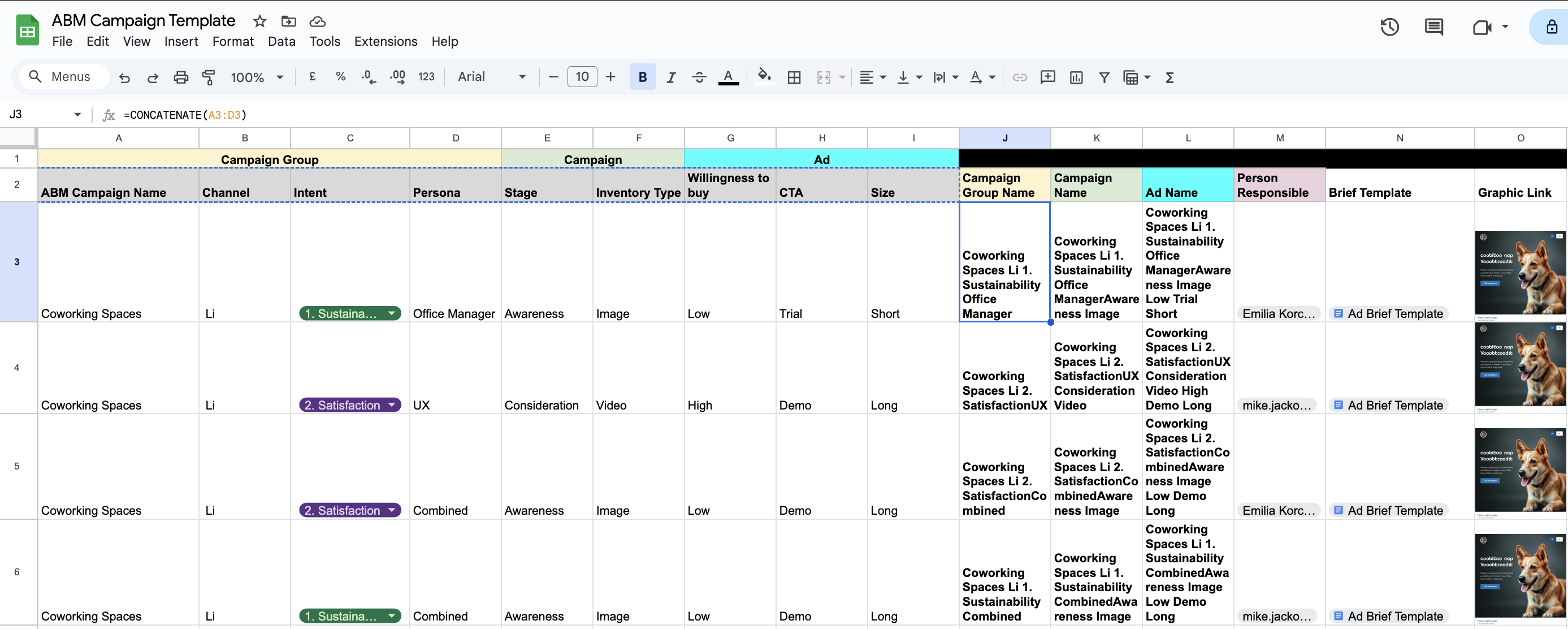
Download this ABM Campaign Management Template in Google Sheets here.
How these templates map to the hierarchy

Each creative is linked to a LinkedIn Ad, which belongs to a LinkedIn Campaign, which lives inside a LinkedIn Campaign Group, which rolls to an ABM Campaign.
- ABM campaign is the top-level go-to-market motion, for example, US Expansion or DACH Mid Market.
- LinkedIn Campaign Group is the intent folder, for example, the Analytics Feature or Feedback Feature.
- LinkedIn Campaign contains a single format, for example image or a video. This keeps budgets and reports clean and comparable. See this guide for more ideas.
- LinkedIn Ad is the final creative. Tag it correctly before uploading to avoid mystery ads and broken reporting.
Step 7: launch, monitor, and keep sales in the loop
Time to go live. Use a simple go-live plan so channels support one another rather than collide.
Coordinated launch
Schedule ads to start, then send the first nurture emails a few days later, and have BDRs ready by week two to react to spikes. Set expectations with sales. Let them know when targets will start seeing ads and when to expect hot lists.
Real time monitoring
Watch performance daily for the first two weeks. Use interim metrics in your template or pull a dashboard. ZenABM has plug-and-play views:

Send CRM alerts when engagement crosses thresholds. ZenABM can push company engagement to CRM, so lists and alerts are always fresh.
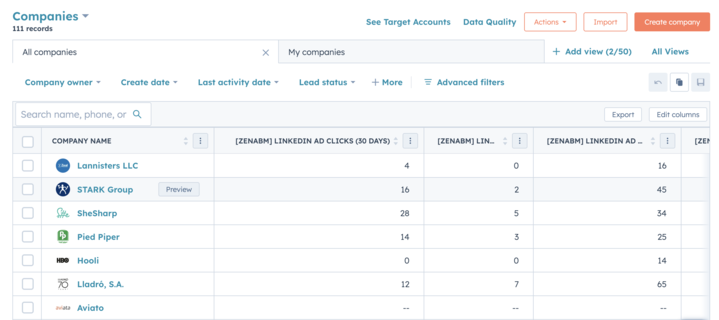
Sales and marketing sync
Keep alignment tight:
- Run a weekly ABM standup with marketing, sales, and RevOps. Review stage movement and decide next steps.
- Do joint account planning for Tier 1. Share content plans and call agendas.
- Enable and train sales with the ads and assets in play so calls reference what buyers already saw.
- Share intent signals with sales. If you tag intent, make it visible in CRM. ZenABM makes this easy:
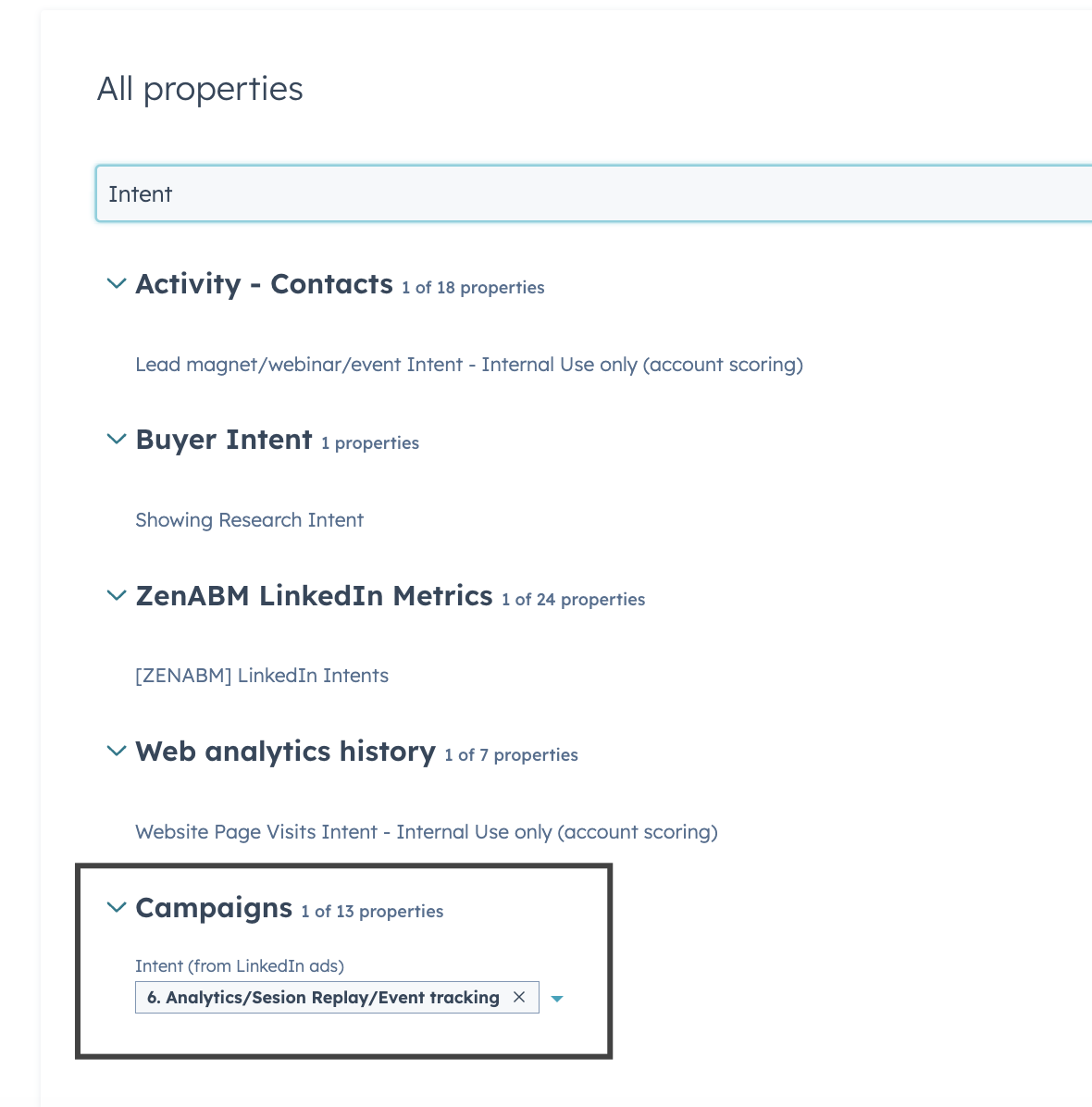
- Set an SLA for follow-up on Marketing Qualified Accounts or highly engaged accounts. Fast contact doubles your odds. ZenABM can assign hot accounts automatically when intent thresholds are met:

Step 8: Dedicate a reporting and analytics section
Your template should include a one-stop analytics view in your CRM or BI tool. At minimum track:
- Pipeline and wins
- Conversion rates by stage
- Ad engagement and spend
- Account progression through stages
- ROI, ROAS, and pipeline per dollar
Report at every level: ABM campaign, campaign group, and LinkedIn campaign. ZenABM includes these views out of the box so you do not need custom SQL.
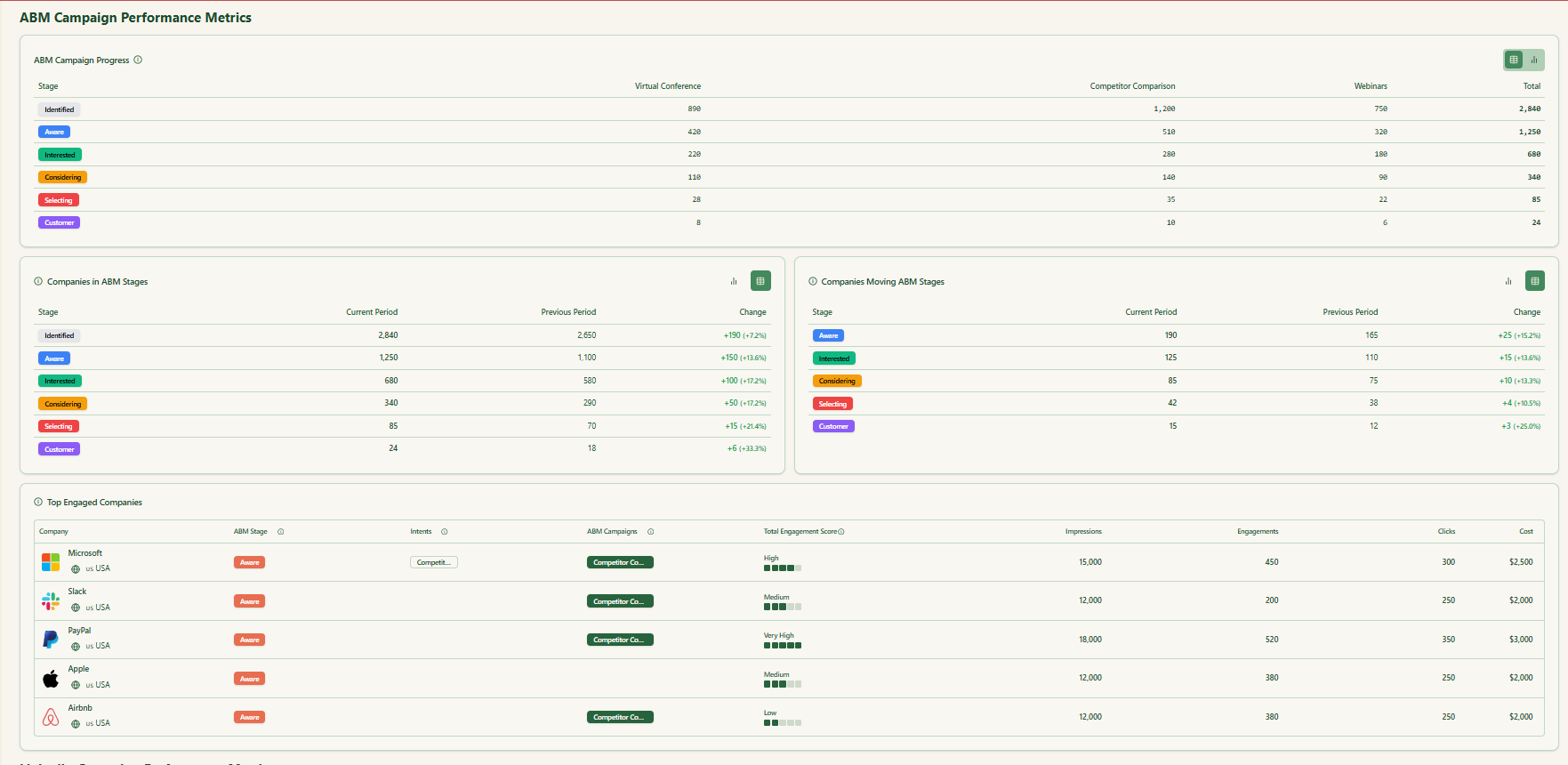



- Ad engagement and spend per company and campaign comes from the official LinkedIn Ads API.
- Deal values for ROI and attribution come from your CRM.
Tools you will want in your LinkedIn ABM structure
| Tool category | Tools | Key features |
|---|---|---|
| CRM | Salesforce, HubSpot | Account and deal tracking, custom ABM fields, account progression, scoring, dashboards |
| Marketing automation and email | Marketo, HubSpot, Pardot, Eloqua | Nurtures, scoring, ad platform integrations, internal alerts |
| Advertising platforms | LinkedIn Campaign Manager, Google Ads, Facebook Ads, Demandbase, RollWorks | Account targeting, matched audiences, customer match, account-based display, retargeting, persona targeting |
| ABM and analytics platforms | ZenABM, 6sense, Demandbase, Triblio, Terminus, RollWorks, Clari | ZenABM: LinkedIn ABM analytics, account-level pipeline and revenue views, automatic CRM sync, buyer intent tagging, LinkedIn ad de-anonymization, ready to use reports. Others: intent data, web personalization, orchestration, forecasting, engagement tracking. |
| Data and enrichment | LinkedIn Sales Navigator, ZoomInfo, Clearbit, BuiltWith, Datanyze, Bombora | Firmographics and ICP research, contact enrichment, technographics, third party intent |
| Sales engagement | Salesloft, Outreach.io, HubSpot Sales Hub, ZenABM | Sequences, personalized outreach, CRM sync, account tracking, automated follow ups |
| Collaboration and asset management | Notion, Asana, Trello, Jira, Google Drive, Dropbox | Campaign planning, project management, shared visibility, content storage |
| Web analytics and personalization | Google Analytics, Clearbit Reveal, Mutiny, Hyperise | Account level signals, ABM analytics, dynamic website content |
| Scheduling and webinars | Calendly, Zoom Webinars, GoToWebinar | Frictionless scheduling, gated events for target accounts |
| Direct mail and gifting | Sendoso, Reachdesk, Alyce | Gifting with CRM integration, delivery tracking, and triggered sends |
Wrapping up your LinkedIn ABM structure
Use this guide to set a structure that grows the pipeline, not just impressions. Copy the templates, plug in ZenABM for company-level engagement and attribution, and get your first LinkedIn ABM motion live. If you want a walkthrough, book a demo, and we will show the dashboards in action.

